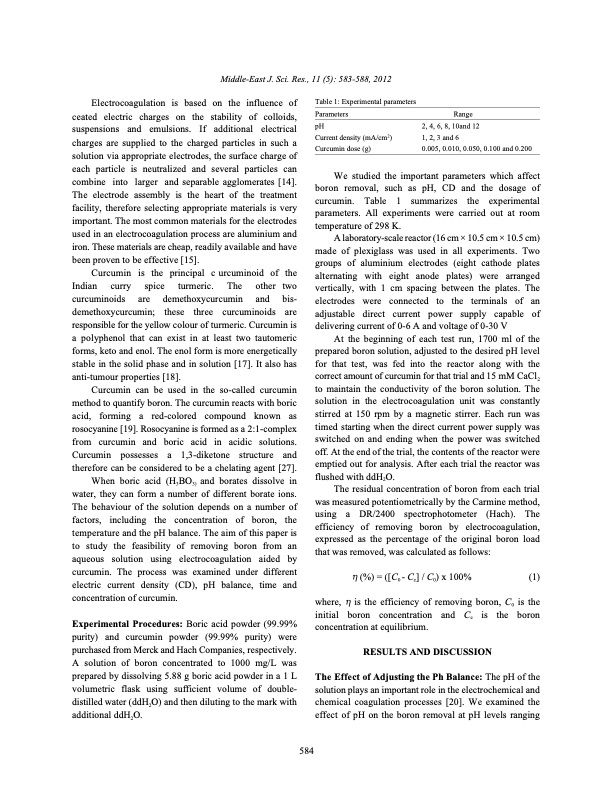
PDF Publication Title:
Text from PDF Page: 002
Electrocoagulation is based on the influence of ceated electric charges on the stability of colloids, suspensions and emulsions. If additional electrical charges are supplied to the charged particles in such a solution via appropriate electrodes, the surface charge of each particle is neutralized and several particles can combine into larger and separable agglomerates [14]. The electrode assembly is the heart of the treatment facility, therefore selecting appropriate materials is very important. The most common materials for the electrodes used in an electrocoagulation process are aluminium and iron. These materials are cheap, readily available and have been proven to be effective [15]. Curcumin is the principal c urcuminoid of the Indian curry spice turmeric. The other two curcuminoids are demethoxycurcumin and bis- demethoxycurcumin; these three curcuminoids are responsible for the yellow colour of turmeric. Curcumin is a polyphenol that can exist in at least two tautomeric forms, keto and enol. The enol form is more energetically stable in the solid phase and in solution [17]. It also has anti-tumour properties [18]. Curcumin can be used in the so-called curcumin method to quantify boron. The curcumin reacts with boric acid, forming a red-colored compound known as rosocyanine [19]. Rosocyanine is formed as a 2:1-complex from curcumin and boric acid in acidic solutions. Curcumin possesses a 1,3-diketone structure and therefore can be considered to be a chelating agent [27]. When boric acid (H3BO3) and borates dissolve in water, they can form a number of different borate ions. The behaviour of the solution depends on a number of factors, including the concentration of boron, the temperature and the pH balance. The aim of this paper is to study the feasibility of removing boron from an aqueous solution using electrocoagulation aided by curcumin. The process was examined under different electric current density (CD), pH balance, time and concentration of curcumin. Experimental Procedures: Boric acid powder (99.99% purity) and curcumin powder (99.99% purity) were purchased from Merck and Hach Companies, respectively. A solution of boron concentrated to 1000 mg/L was prepared by dissolving 5.88 g boric acid powder in a 1 L volumetric flask using sufficient volume of double- distilled water (ddH2O) and then diluting to the mark with additional ddH2O. Table 1: Experimental parameters Parameters pH Current density (mA/cm2) Curcumin dose (g) Range 2, 4, 6, 8, 10and 12 1, 2, 3 and 6 0.005, 0.010, 0.050, 0.100 and 0.200 Middle-East J. Sci. Res., 11 (5): 583-588, 2012 584 We studied the important parameters which affect boron removal, such as pH, CD and the dosage of curcumin. Table 1 summarizes the experimental parameters. All experiments were carried out at room temperature of 298 K. A laboratory-scale reactor (16 cm × 10.5 cm × 10.5 cm) made of plexiglass was used in all experiments. Two groups of aluminium electrodes (eight cathode plates alternating with eight anode plates) were arranged vertically, with 1 cm spacing between the plates. The electrodes were connected to the terminals of an adjustable direct current power supply capable of delivering current of 0-6 A and voltage of 0-30 V At the beginning of each test run, 1700 ml of the prepared boron solution, adjusted to the desired pH level for that test, was fed into the reactor along with the correct amount of curcumin for that trial and 15 mM CaCl2 to maintain the conductivity of the boron solution. The solution in the electrocoagulation unit was constantly stirred at 150 rpm by a magnetic stirrer. Each run was timed starting when the direct current power supply was switched on and ending when the power was switched off. At the end of the trial, the contents of the reactor were emptied out for analysis. After each trial the reactor was flushed with ddH2O. The residual concentration of boron from each trial was measured potentiometrically by the Carmine method, using a DR/2400 spectrophotometer (Hach). The efficiency of removing boron by electrocoagulation, expressed as the percentage of the original boron load that was removed, was calculated as follows: (%) = ([C0 - Ce] / C0) x 100% (1) where, is the efficiency of removing boron, C0 is the initial boron concentration and Ce is the boron concentration at equilibrium. RESULTS AND DISCUSSION The Effect of Adjusting the Ph Balance: The pH of the solution plays an important role in the electrochemical and chemical coagulation processes [20]. We examined the effect of pH on the boron removal at pH levels rangingPDF Image | Boron Removal from Aqueous Solutions

PDF Search Title:
Boron Removal from Aqueous SolutionsOriginal File Name Searched:
boron-curcumin.pdfDIY PDF Search: Google It | Yahoo | Bing
CO2 Organic Rankine Cycle Experimenter Platform The supercritical CO2 phase change system is both a heat pump and organic rankine cycle which can be used for those purposes and as a supercritical extractor for advanced subcritical and supercritical extraction technology. Uses include producing nanoparticles, precious metal CO2 extraction, lithium battery recycling, and other applications... More Info
Heat Pumps CO2 ORC Heat Pump System Platform More Info
| CONTACT TEL: 608-238-6001 Email: greg@infinityturbine.com | RSS | AMP |